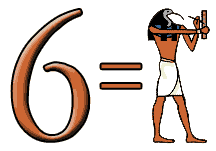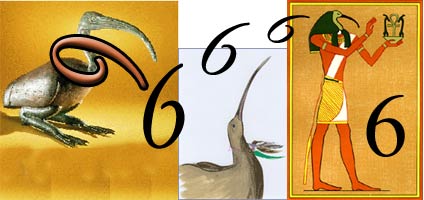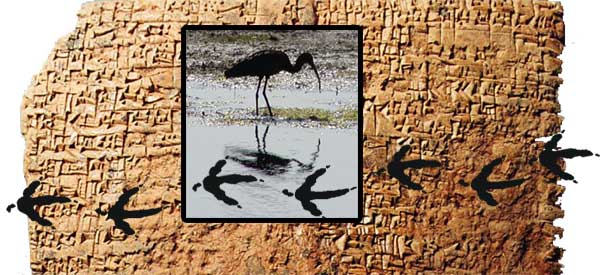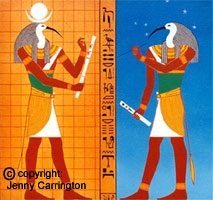 ©
©
 The number 6 represents Thoth, the god of wisdom and learning.
The number 6 represents Thoth, the god of wisdom and learning.

The number 6 is a picture of the head of an ibis.
In Egyptian art, Thoth is depicted as an ibis headed god. Thoth was the scribe of the gods. He was the patron god of scribes. According to the foundation legend of Egypt, Thoth was the inventor of writing and of numbers. Scribes of the Thoth school created the letters of the Roman alphabet and the numbers of the Arabic number set. They used Pagan religious icons to create the symbols that are the letters and numbers we know and use today. The number 6 is a Pagan religious icon. We use Pagan religious icons to record and communicate the content of our thoughts. Our languages and cultures are rooted in the ancient culture of Isis.

Cuneiform writing reminded the ancients of bird tracks in mud.
Pagans of the Isis bloodline valued wisdom as the highest human virtue. The "Sacred Ibis" was an enduring wisdom symbol in Pagan religion. One might wonder why they chose the ibis as a symbol to represent the god of wisdom and learning. The common pun that someone's handwriting looks like "chicken tracks" has truly ancient origins. The earliest enduring forms of writing were impressions made in clay. The ibis is a wading bird that probes for food in shallow waters along streams and ponds. Its footprints in the mud of its habitat reminded the scribes of cuneiform clay tablet writing.
The Pagan's concept of wisdom was divided into distinctly different branches of wisdom. The educated wisdom of scribes was regarded differently from the agrarian wisdom of farmers or the military wisdom of soldiers. Farmers, soldiers, and "tradesmen" of all kinds were illiterate classes of people. Heru, the hawk god, was the patron god of soldiers who did not need to be educated in the literary arts. When armies went on military campaigns, professional scribes went along as accountants, message writers, and etc. The common feature of armies subservient to civilian governments in Western civilizations may have sprung originally from this ancient literary tradition.
Thoth was the patron god of all the scientific, literary, and bureaucratic professions that required writing skills. They chose the ibis as the symbol for the patron god of the educated literary branch of wisdom because its footprints looked like cuneiform clay tablet writing.
ADDENDUM #1
Priest scribes of the Thoth school were linguistic architects and wordsmiths. They designed languages and formulated words.
According to conventional language theories, our modern languages "evolved" from prehistoric languages by chance. There was no design or designer involved in the process. That isn't true. Our languages are man-made structures in much the same way that our houses are man-made structures. Our houses may be built of wood from forests that evolved out of the ecosystem of the planet, but the houses did not evolve out of the forest by chance.
For the most part, constructors of houses refined and formulated naturally existing materials to create the products from which they built houses. Ironsmiths refined nails out of raw iron ore. Sawyers sawed lumber from naturally existing trees. They built their houses on foundations of field stone mortared together to serve their purpose. Scribes of the Thoth school designed and constructed languages by similar processes. Our major languages are structures built partly of linguistic materials from prehistorical times and partly from the creations of Thothian genius.
For instance, Thothian scribes used the names of gods and the functions of those gods to formulate words and give them meaning. Thoth was the all around god of wisdom and learning. Our word thought is derived from the name of Thoth. Our word hero is derived from the name of Heru, the god of wisdom in action. Our word assure is derived from the name of Assur, the founding father god of Pagan civilization. Those are very direct god name words that derive their sounds and meanings from the names and functions of Pagan gods. Many words in many languages are derivatives of god names. They're not always as direct and obvious as these examples are.

Thoth was the god of writing and also of science and mathematics. Tekh was another of Thoth's names. The Tekh version of his name is found in a variety of technical terms like Tekhnology. The tech- syllable in technology is derived from the god name Tekh. The -tic syllable in mathematic is derived from Tekh. Thoth was the god of astronomy. He was the counter of the stars, the maker of the calendar, and the measurer of time. The tick-tock of the clock is derived from the name of Tekh. It was Thoth who "first taught men to speak clearly." Our word talk (tawk) is derived from Tekh. Thoth was the god of writing. Our word text is derived from Tekh. Thoth was wise. Our word tactic is derived from Tekh-Tekh.
Resurrect Isis All that we know as human civilization, our cultures, our languages, our genealogies, are rooted in the old Pagan religion of EarthMother Goddess, Isis. In order for a peaceful and prosperous world civilization to exist on this planet that leaves out no part of humanity, we must return to our roots. The only alternative is a civilization based on predatory militarism as it is being practiced and promulgated over the world today.
|
Reader responses are invited. |
Return to Home Page . . . Return to Table of Contents Hub
Links to number pages:
Number 5 Page . . . Number 7 Page . . .
Links to related topic pages
Visual Language . . . Tower of Babel . . . Babel of Tongues . . .
Links to related alphabet pages
Alphabet T page . . .